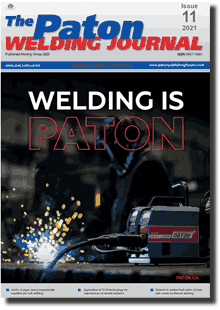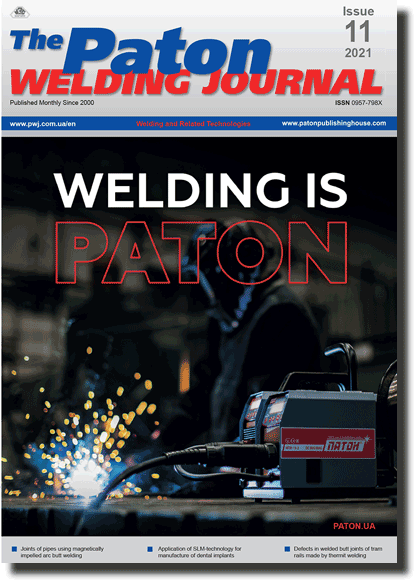| 2021 №11 (08) |
DOI of Article 10.37434/tpwj2021.11.01 |
2021 №11 (02) |

The Paton Welding Journal, 2021, #11, 3-8 pages
Modeling of thermal processes in laser welding of polymers
M.G. Korab1, M.V. Iurzhenko1, A.V. Vashchuk1, I.K. Senchenkov2
1E.O. Paton Electric Welding Institute of the NASU. 11 Kazymyr Malevych Str., 03150, Kyiv, Ukraine. E-mail: 4chewip@gmail.com
2S.P. Timoshenko Institute of Mechanics of the NASU 3 Nesterov Str., 03057, Kyiv, Ukraine
Abstract
In the work, a mathematical description of thermal processes in laser welding with the use of the classical theory of thermal conductivity was performed. The thermal cycle under the action of radiation on the surface was analyzed using the models of overall heat balance, distributed surface, point, circular and linear heat sources. The modeling of welding process consisted in solving the problem of forming thermal fields in viscoelastic polymer materials at a moving inner heat source. It was assumed that the upper part is transparent to laser radiation and the lower one has a set coefficient of light beam absorption, and their thermophysical characteristics depend on temperature. The equations of thermal conductivity and defining equations were formulated, supplemented by the boundary conditions of convective heat transfer and the initial temperature distribution. For the numerical implementation of certain equations the finite element method was used, which is based on an alternative formulation of the problem. The results of mathematical modeling showed the peculiarities of the formation of thermal fields in the transmission laser welding of polymer films at different parameters of welding mode.
Keywords: laser welding, polymer films, mathematical modeling, thermal processes, temperature fields, isotherms
Received 20.09.2021
Accepted: 29.11.2021
References
1. Klein, R. (2011) Laser welding of plastics. Wiley-VCH, Verlag GmbH & Co. https://doi.org/10.1002/97835276369692. Buketov, A., Brailo, M., Yakushchenko, S., Sapronova, A. (2018) Development of epoxy-polyester composite with improved thermophysical properties for restoration of details of sea and river transport. Advances in Materials Science and Engineering, 6378782. https://doi.org/10.1155/2018/6378782
3. Acherjee, B., Kuar, A.S., Misra, D., Mitra, S. (2011) Laser transmission welding of thermoplastics: An overview of experimental findings - process, development and applications. Journal of Manufacturing Technology Research., 3, 211-236.
4. Kneip, J.C., Martin, B., Loredo, A. et al. (2004) Heat transfer in semitransparment materials during laser interaction. Journal of Materials Processing Technology, 155-156, 1805-1809. https://doi.org/10.1016/j.jmatprotec.2004.04.380
5. Ruotsalainen, S., Laakso, P., Kujanpa, V. (2015) Laser welding of transparent polymers by using quasi-simultaneous beam off-setting scanning technique. Physics Procedia, 78, 272-284. https://doi.org/10.1016/j.phpro.2015.11.038
6. Majumdar, A., D`Alvise, L. (2016) Simulation of the laser transmission welding of thermoplastics - оSensitivity to process parameters. Proceedings of the NAFEMS Nordic Conference available at: https://www.researchgate.net/publication/304308496
7. Delone N.B. (1989) Interaction of laser radiation with substance. Moscow, Nauka [in Russian].
8. Vedenov, A.A., Gladush, G.G. (1985) Physical processes in laser treatment of materials. Moscow, Energoatomizdat [in Russian].
9. Kutateladze, S.S. (1979) Fundamentals of the theory of heat exchange. Moscow, Atomizdat [in Russian].
10. Lykov, A.V. (1967) Theory of heat conductivity. Moscow, Vysshaya Shkola [in Russian].
Suggested Citation
M.G. Korab, M.V. Iurzhenko, A.V. Vashchuk, I.K. Senchenkov (2021) Modeling of thermal processes in laser welding of polymers. The Paton Welding J., 11, 3-8.The cost of subscription/purchase order journals or individual articles
| Journal/Currency | Annual Set | 1 issue printed |
1 issue |
one article |
| TPWJ/USD | 384 $ | 32 $ | 26 $ | 13 $ |
| TPWJ/EUR | 348 € | 29 € | 24 € | 12 € |
| TPWJ/UAH | 7200 UAH | 600 UAH | 600 UAH | 280 UAH |
| AS/UAH | 1800 UAH | 300 UAH | 300 UAH | 150 UAH |
| AS/USD | 192 $ | 32 $ | 26 $ | 13 $ |
| AS/EUR | 180 € | 30 € | 25 € | 12 € |
| SEM/UAH | 1200 UAH | 300 UAH | 300 UAH | 150 UAH |
| SEM/USD | 128 $ | 32 $ | 26 $ | 13 $ |
| SEM/EUR | 120 € | 30 € | 25 € | 12 € |
| TDNK/UAH | 1200 UAH | 300 UAH | 300 UAH | 150 UAH |
| TDNK/USD | 128 $ | 32 $ | 26 $ | 13 $ |
| TDNK/EUR | 120 € | 30 € | 25 € | 15 € |
AS = «Automatic Welding» - 6 issues per year;
TPWJ = «PATON WELDING JOURNAL» - 12 issues per year;
SEM = «Electrometallurgy Today» - 4 issues per year;
TDNK = «Technical Diagnostics and Non-Destructive Testing» - 4 issues per year.


